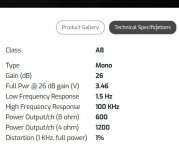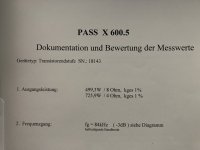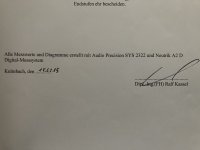I have a pair of Pass Labs X600.5 monaural amplifiers with the following specs according to this webpage: https://www.passlabs.com/legacy_products/x600-5

600 Watts at 8 Ohms with 1% Distortion
1200 Watts at 4 Ohms with 1% Distortion
A professional engineer made the following measured powerratings:

499,3 Watts at 8 Ohms with 1% Distortion
725,9 Watts at 4 Ohms with 1% Distortion
He even signs for it:

This discrepancy in power output is significant especially at 4 Ohms where almost 500 Watts seems to be disappeared.
As far as I know the tech is a professional working for decades in the field of highendaudio repairs.
I'm in no way implying that there's been any wrong intention by any party concerned, relating to these figures.
It's only one specific pair of X600.5's I'm referring to and I can't generalize on that base.
Maybe you can shed some light on this.
PS I edited the original post so my question is a more open minded query than a suggestion that the specified values were wrong.

600 Watts at 8 Ohms with 1% Distortion
1200 Watts at 4 Ohms with 1% Distortion
A professional engineer made the following measured powerratings:

499,3 Watts at 8 Ohms with 1% Distortion
725,9 Watts at 4 Ohms with 1% Distortion
He even signs for it:

This discrepancy in power output is significant especially at 4 Ohms where almost 500 Watts seems to be disappeared.
As far as I know the tech is a professional working for decades in the field of highendaudio repairs.
I'm in no way implying that there's been any wrong intention by any party concerned, relating to these figures.
It's only one specific pair of X600.5's I'm referring to and I can't generalize on that base.
Maybe you can shed some light on this.
PS I edited the original post so my question is a more open minded query than a suggestion that the specified values were wrong.
Last edited:
Is the 600/1200W continuous sinus power (20 - 20 KHz) into a pure ohmic impedance?
Normally such figures follow a specification. It could be ISO, DIN or whatever?
Normally such figures follow a specification. It could be ISO, DIN or whatever?
I vote for a sagging AC line, despite your disclaimer.
You can bank on that 2008 amp meeting its specs, unless the power supply is degraded due to use or age.
You can bank on that 2008 amp meeting its specs, unless the power supply is degraded due to use or age.
Last edited:
one non-engineer could say - plenty close to enough power
though, who am I to say anything against mucho cojones amps, Pa is rich because of them
though, who am I to say anything against mucho cojones amps, Pa is rich because of them
I have a pair of Pass Labs X600.5 monaural amplifiers with the following specs according to this webpage: https://www.passlabs.com/legacy_products/x600-5
View attachment 1105304
600 Watts at 8 Ohms with 1% Distortion
1200 Watts at 4 Ohms with 1% Distortion
A professional engineer made the following measured powerratings:
View attachment 1105305
499,3 Watts at 8 Ohms with 1% Distortion
725,9 Watts at 4 Ohms with 1% Distortion
He even signs for it:
View attachment 1105307
This discrepancy in power output is significant especially at 4 Ohms where almost 500 Watts "disappeared".
My loudspeakers do not starve for power but it seems to be far from a perfect voltage source as is suggested in the product literature with the doubling of power when the load is halved namely 600 to 1200 Watts.
How can that be? Don't say his AC collapses from 230 Volts to 170 Volts when driving the 4 Ohm load. This is a professional working for decades in the field of highendaudio repairs.
If you do not like it, I will take it. You have to pay shipping though.
If the 600/1200 W ratings is peak power and the measured are "average power" then you probably have to multiply measured power by 2 to get peak power if input signal was a sinus?
I am tempted to say that too. Every review of a pass amplifier I have read has it considerably exceeding spec. Now even if it was low by that much you are only talking 1.7dB into a 4 Ohm load which in normal operation you are not going to spot anyway. And domestically that's an insane amount of power.I vote for a sagging AC line, despite your disclaimer.
You can bank on that 2008 amp meeting its specs, unless the power supply is degraded due to use or age.
Well this is just typical. I have a 5 watt F2, but it seems it softclips at 4,5 watts. What an utter disaster! 

Well, i measure less than one watt at normal listening volume on the speaker with memory oscilloscope.
https://geoffthegreygeek.com/understanding-amplifier-power/
https://geoffthegreygeek.com/understanding-amplifier-power/
That simply can’t be. You need at least 1kW to enjoy the music!Well, i measure less than one watt at normal listening volume on the speaker with memory oscilloscope.
https://geoffthegreygeek.com/understanding-amplifier-power/
I haven’t measured that yet, but I think I am at approx 1,5-2 watts @ normal levels. But of course, speakers differ wildly. Apogees need something different than a FR.
I've no idea but does it matter? The X600.5 has a balanced and single ended input and I assume that the powerratings specified by Pass Labs aren't different because of the kind of input that it uses. So it's not 1200 Watts with the balanced input and 726 Watts with the single ended input at 4 Ohms.I'm just curious. Was it tested balanced or unbalance?
As said I got the specification from the Pass Labs website and I assume it's continuous power from 20 Hz to 20kHz with 1% distortion. The model is called X600.5 and the 600 reflects it's a 600 Watt amplifier at 8 Ohms, like the X1000 is a 1000 Watt amplifier and so forth.Is the 600/1200W continuous sinus power (20 - 20 KHz) into a pure ohmic impedance?
Normally such figures follow a specification. It could be ISO, DIN or whatever?
Haha, I do not need more power even with my low impedence low efficiency Infinity's. I received these reports yesterday and I was curious why both these amplifiers did not meet their specified ratings. Especially at 4 Ohms the difference is pretty significant. I suspect that the Plitron transformer can't sustain the railvoltage needed to double the output from 8 to 4 Ohms. I also suspect that with the XA160.5 the Class A version of the (bridged) X600.5 with basically the same hardware, will behave much more as a perfect voltage source than the X600.5. I think the same is true for the X100.5 and XA200.5.one non-engineer could say - plenty close to enough power
though, who am I to say anything against mucho cojones amps, Pa is rich because of them
If these ratings were peak power it would have been stated in the specifications. I even believe in the USA it's obligatory by FTC Rule 16 CFR Part 432 to specify these powerratings for home entertaining amplifiers and the conditions they were made in: https://www.ecfr.gov/current/title-16/chapter-I/subchapter-D/part-432. So you can't state a power rating and say later when asked: "Yeah we meant peak power of course... "If the 600/1200 W ratings is peak power and the measured are "average power" then you probably have to multiply measured power by 2 to get peak power if input signal was a sinus?
That's 10% difference where as 1200 to 726 Watts is a 40% difference. Makes quite a difference won't you say ;-)Well this is just typical. I have a 5 watt F2, but it seems it softclips at 4,5 watts. What an utter disaster!
That's a very tempting proposal ...If you do not like it, I will take it. You have to pay shipping though.
Last edited:
Of course, I was just joking.That's 10% difference where as 1200 to 726 Watts is a 40% difference. Makes quite a difference won't you say ;-)
If I were you, I’d simply drop Papa an e-mail and explain the situation. He should have an explanation, and IME he always aims to please both customers and greedy boyz.
- Status
- Not open for further replies.
- Home
- Amplifiers
- Pass Labs
- Measured vs Specified power ratings of Pass X600.5